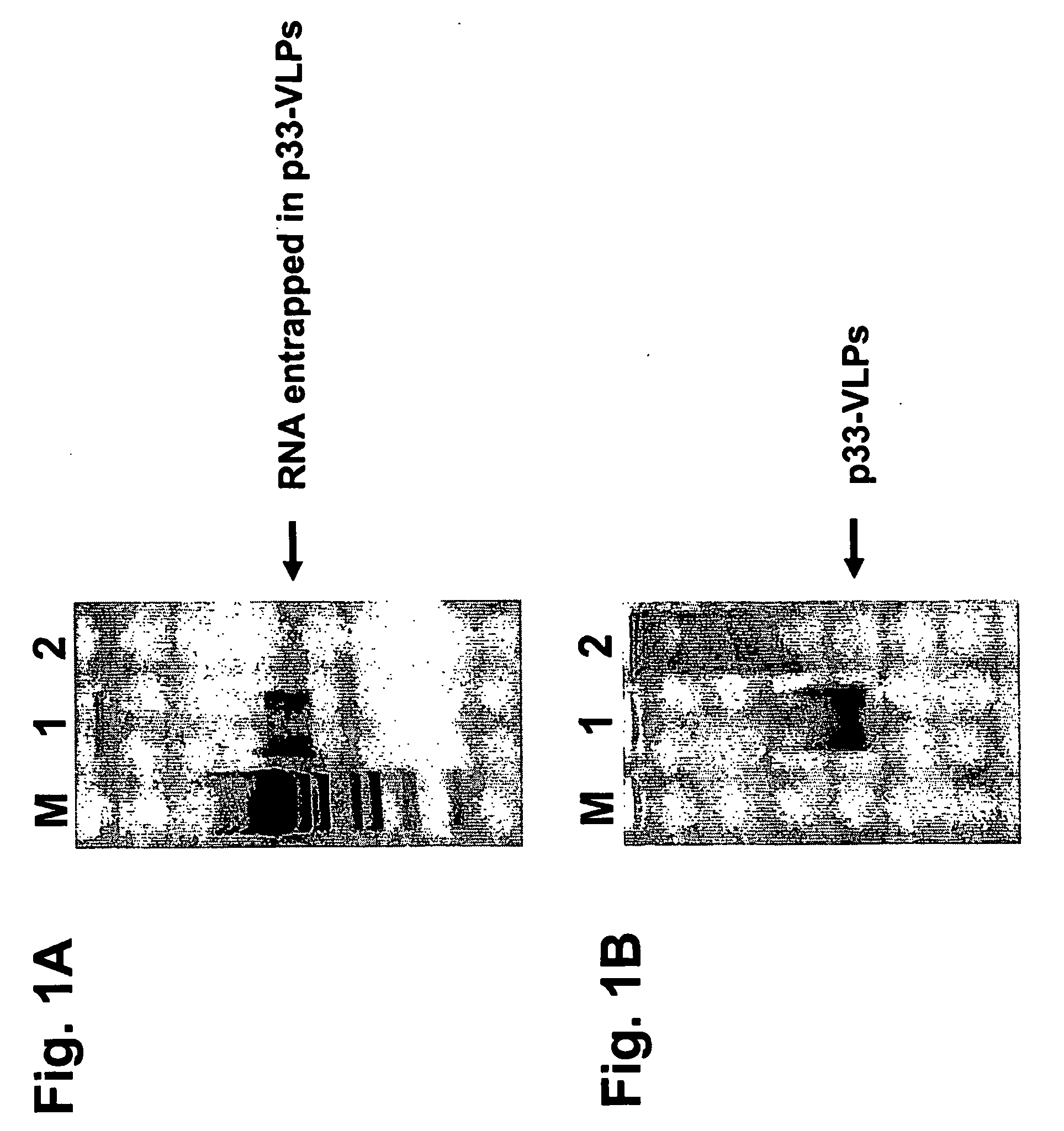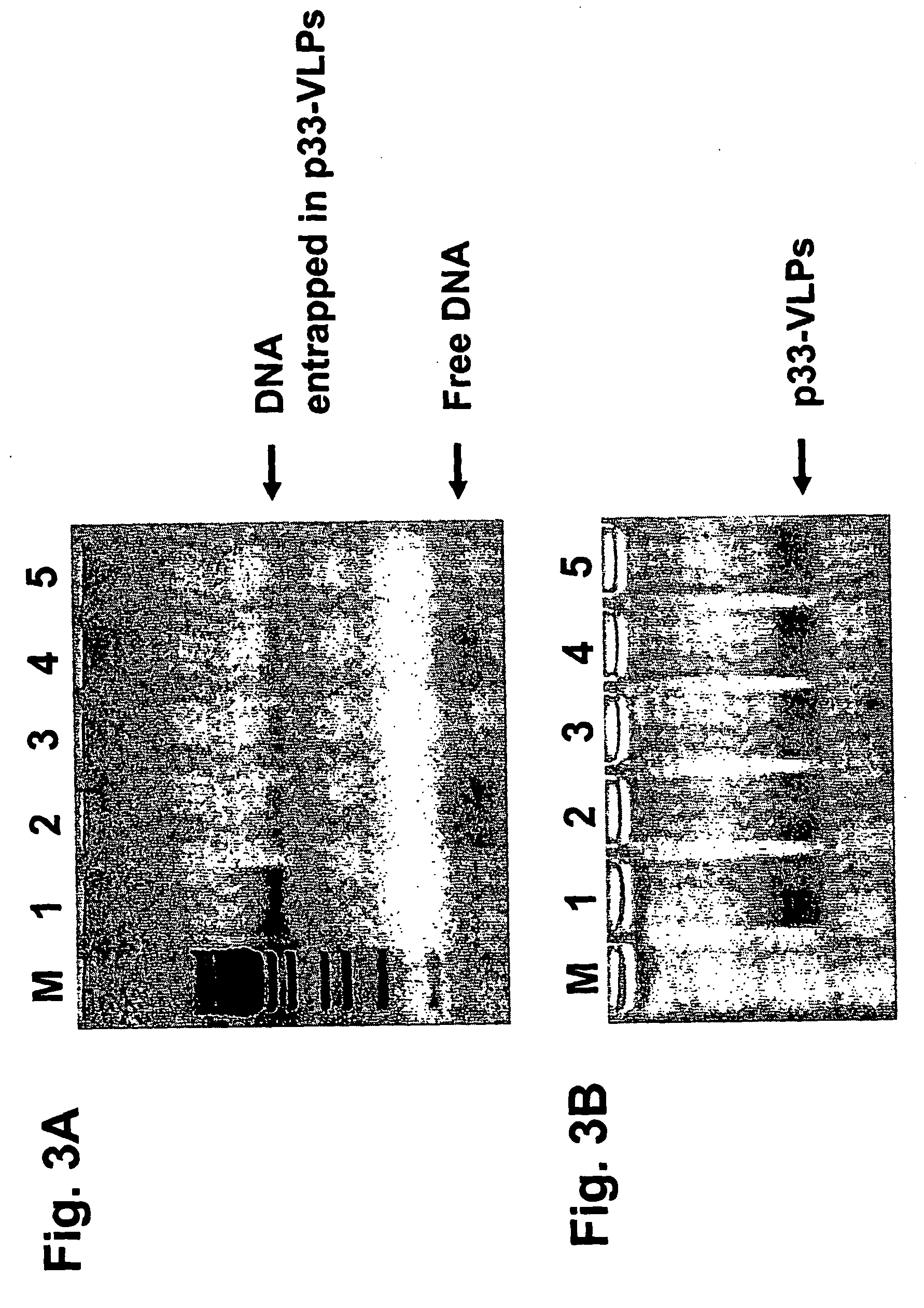Packaged virus-like particles
a virus-like particle and packaging technology, applied in the field of vaccines, immunology and medicine, can solve the problems of immune system usually failing to produce antibodies against self-derived structures, self-antigens to carriers that can deliver t help may break tolerance, and it is difficult to induce antibody responses against self-antigens, etc., to enhance b and t cell responses, enhance vlp-induced t responses, and enhance antigen t cell responses
- Summary
- Abstract
- Description
- Claims
- Application Information
AI Technical Summary
Benefits of technology
Problems solved by technology
Method used
Image
Examples
example 1
[0174] Generation of VLPs
[0175] The DNA sequence of HBcAg containing peptide p33 from LCMV is given in SEQ ID NO: 12. The p33-HBcAg VLPs (p33-VLPs) were generated as follows: Hepatitis B clone pEco63 containing the complete viral genome of Hepatitis B virus was purchased from ATCC. The generation of the expression plasmid has been described previously (see WO 03 / 024481).
[0176] A clone of E. coli K802 selected for good expression was transfected with the plasmid, and cells were grown and resuspended in 5 ml lysis buffer (10 mM Na2HPO4, 30 mM NaCl, 10 mM EDTA, 0.25% Tween-20, pH 7.0). 200 μl of lysozyme solution (20 mg / ml) was added. After sonication, 4 μl Benzonase and 10 mM MgCl2 was added and the suspension was incubation for 30 minutes at RT, centrifuged for 15 minutes at 15,000 rpm at 4° C. and the supernatant was retained.
[0177] Next, 20 % (w / v) (0.2 g / ml lysate) ammonium sulfate was added to the supernatant. After incubation for 30 minutes on ice and centrifugation for 15 mi...
example 2
[0179] CpG-Containing Oligonucleotides can be Packaged into HBcAg VLPs.
[0180] Recombinant VLPs generated as described in Example 1 were run on a native agarose (1%) gel electrophoresis and stained with ethidium bromide or Coomassie blue for the detection of RNA / DNA or protein (FIG. 1). Bacterial produced VLPs contain high levels of single stranded RNA, which is presumably binding to the arginine repeats appearing near the C-terminus of the HBcAg protein and being geographically located inside the VLPs as shown by X-ray crystallography. The contaminating RNA can be easily digested and so eliminated by incubating the VLPs with RNase A. The highly active RNase A enzyme has a molecular weight of about 14 kDa and is presumably small enough to enter the VLPs to eliminate the undesired ribonucleic acids.
[0181] The recombinant VLPs were supplemented with CpG-rich oligonucleotides (see SEQ ID NO: 11) before digestion with RNase A. As shown in FIG. 2 the presence of CpG-oligonucleotides pre...
example 3
[0182] CpG-Containing Oligonucleotides can be Packaged into VLPs by Removal of the RNA with RNAse and Subsequent Packaging of Oligonucleotides into VLPs.
[0183] The VLPs (containing bacterial single-stranded RNA arid generated as described in Example 1) were first incubated with RNaseA to remove the RNA and in a second step the immunostimulating CpG-oligonucleotides (with normal phosphodiester moieties but also with phosphorothioate modifications of the phosphate backbone) was supplemented to the samples (FIG. 4). This experiment clearly shows that the CpG-oligonucleotides are not absolutely required simultaneously during the RNA degradation reaction but can be added at a later time.
PUM
| Property | Measurement | Unit |
|---|---|---|
| Immunostimulation | aaaaa | aaaaa |
| Immunogenicity | aaaaa | aaaaa |
| Cytotoxicity | aaaaa | aaaaa |
Abstract
Description
Claims
Application Information
 Login to View More
Login to View More - R&D
- Intellectual Property
- Life Sciences
- Materials
- Tech Scout
- Unparalleled Data Quality
- Higher Quality Content
- 60% Fewer Hallucinations
Browse by: Latest US Patents, China's latest patents, Technical Efficacy Thesaurus, Application Domain, Technology Topic, Popular Technical Reports.
© 2025 PatSnap. All rights reserved.Legal|Privacy policy|Modern Slavery Act Transparency Statement|Sitemap|About US| Contact US: help@patsnap.com



